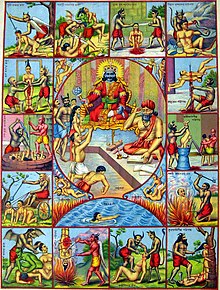Naraka

Naraka (
Alternatively, the "hellish beings" that are said to reside in this underworld are often referred to as Narakas. These beings are also termed in
Hinduism

Naraka is a realm in the
In Puranas like Bhagavata Purana, Garuda Purana, and Vishnu Purana, there are elaborate descriptions of many hells. They are situated above the Garbhodaka Ocean.[13] The Vishnu Purana mentions the names of the various Narakas:[14]
The names of the different Narakas are as follows: Raurava, Śūkara, Rodha, Tāla, Viśasana, Mahājvāla, Taptakumbha, Lavaṇa, Vimohana, Rudhirāndha, Vaitaranī, Krimīśa, Krimibhojana, Asipatravana, Kṛṣṇa, Lālābhakṣa, Dāruṇa, Pūyavāha, Pāpa, Vahnijvāla, Adhośiras, Sandansa, Kālasūtra, Tamas, Avīci, Śvabhojana, Apratiṣṭha, and another Avīci. These and many other fearful hells are the awful provinces of the kingdom of Yama, terrible with instruments of torture and with fire; into which are hurled all those who are addicted when alive to sinful practices.
— Vishnu Purana, Book 2, Chapter 6
Yama Loka is the abode of Yama. Yama is also referred to as the Dharmaraja, or the king of dharma; Yama Loka may be compared to a temporary purgatorium for sinners (papi). According to Hindu scriptures, Yama's divine assistant, Chitragupta, maintains a record of the individual deeds of every living being in the world, and based on the complete audit of his deeds, dispatches the soul of the deceased either to Svarga (Heaven), or to the various Narakas, according to the nature of their sins. The scriptures describe that even people who have done a majority of good deeds could come to Yama Loka for redemption from the minor sins they have committed, and once the punishments have been served for those sins, they could be sent for rebirth to earth or to heaven.
At the time of death,
Buddhism
In Buddhism, Naraka refers to the worlds of greatest suffering.
Jainism
In Jainism, Naraka is the name given to realm of existence in Jain cosmology having great suffering. The length of a being's stay in a Naraka is not eternal, though it is usually very long—measured in billions of years. A soul is born into a Naraka as a direct result of his or her previous karma (actions of body, speech and mind), and resides there for a finite length of time until his karma has achieved its full result. After his karma is used up, he may be reborn in one of the higher worlds as the result of an earlier karma that had not yet ripened. Jain texts mention that these hells are situated in the seven grounds at the lower part of the universe. The seven grounds are:
- Ratna prabha
- Sharkara prabha
- Valuka prabha
- Panka prabha
- Dhuma prabha
- Tamaha prabha
- Mahatamaha prabha
See also
- Shurangama Sutra– Volume 6, Chapter 5: The Twelve Categories of Living Beings
- List of numbers in Hindu scriptures
References
- ISBN 9781137012333p. 195
- ^ Śukla Yajur Veda 30.5
- ^ Atharva Veda 12.4.36
- ^ Aitareya Āraṇyaka 2.3.2.4,5
- ^ Mahanārāyaṇa Upaniṣad 1.50
- ^ Praśna Upaniṣad 3
- ^ Nirālamba Upaniṣad 2, 17
- ^ Paramahaṃsa Upaniṣad 3
- ^ asuryā nāma te lokā andhena tamasāvṛtāḥ – Īśa Upaniṣad 3
- ^ 1.41, 1.43, 16.16, 16.21
- ^ Vedānta sūtra 4.3.14
- ^ Helmuth von Glasenapp: Der Hinduismus. Religion und Gesellschaft im heutigen Indien, Hildesheim 1978, p. 248.
- ^ Bhāgavata Purāṇa 5.26.5
- ^ www.wisdomlib.org (2014-08-30). "Account of the different hells, or divisions of Naraka [Chapter VI]". www.wisdomlib.org. Retrieved 2022-08-08.
- ^ www.wisdomlib.org (2014-08-30). "Account of the different hells, or divisions of Naraka [Chapter VI]". www.wisdomlib.org. Retrieved 2022-08-08.
- ^ Bhakti Schools of Vedanta, by Swami Tapasyananda
- ^ Bhāgavata Purāṇa 5.26.37
- ^ Garuḍa Purāṇa 2.10.88–89, 2.46.9–10,28
- ^ Bhāgavata Purāṇa 6.3
- ^ Nṛsiṃha Purāṇa 9.1–2
External links
- Definition at godrealized.com
- Wat Thawet Buddhist Learning Garden Feature Article


